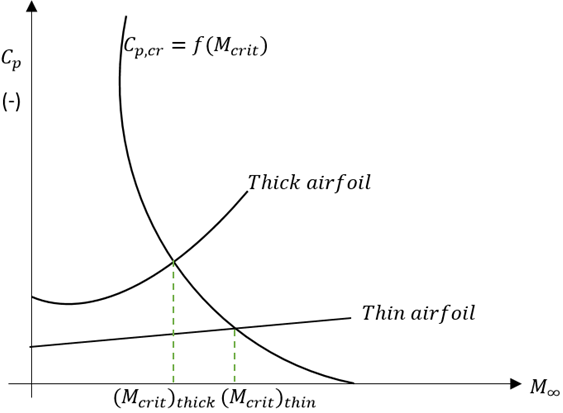This set of Aerodynamics Multiple Choice Questions & Answers (MCQs) focuses on “The Supercritical Airfoil”.
1. What is a critical Mach number?
a) Mach number at which transonic flow is achieved on the surface
b) Mach number at which sonic flow is achieved on the surface
c) Mach number at which wake formation does not exist
d) Mach number at which the coefficient of lift is minimum
View Answer
Explanation: When freestream air flows over an airfoil at suppose Mach number = 0.3, there’s a point on the top surface of the airfoil where the pressure is minimum and the Mach number is maximum such as 0.43. When this freestream velocity is increased, there’s a certain Mach number for which sonic flow is achieved at the top surface. This is known as the critical Mach number.
2. High speed subsonic aircrafts are designed with thick airfoil wings.
a) True
b) False
View Answer
Explanation: The flow over thin airfoil experiences less perturbation and Cp0 value is negative Cp0 with a smaller magnitude. On the other hand thick airfoils experience higher perturbation resulting in negative of larger magnitude. Thus on seeing the graph, thick airfoil has lower critical Mach number compared to the thin airfoil. This is the reason why high speed subsonic aircrafts make use of thinner airfoils.

3. What is the reason for a sudden increase in drag beyond drag divergence?
a) Transonic region on top surface of the airfoil
b) Supersonic region on top and bottom region of the airfoil
c) Prandt- Glauert compressibility effect
d) The shape of the airfoil
View Answer
Explanation: When the Mach number is increased beyond the point of drag divergence, the drag decreases by a factor of 10 due to the formation of supersonic region in both top and bottom surfaces of the airfoil. This supersonic region is followed by a shock wave which leads to flow separation causing higher drag.
4. What is the purpose of supercritical airfoil?
a) Reduce critical Mach number
b) Increase drag divergence Mach number
c) Reduce drag divergence Mach number
d) Increase lift of the airfoil at supersonic speed
View Answer
Explanation: The purpose of a supercritical airfoil to delay the drag divergence Mach number so that there is a delay in wave drag formation which begins at the transonic speed. It aims to increase the Mach number increment between the critical Mach number and drag divergence Mach number.
5. How is supercritical airfoil different from the NACA 64 series airfoil?
a) Thinner airfoil
b) Less cambered
c) Flatter top surface
d) Flatter lower surface
View Answer
Explanation: The supercritical airfoils have a flatter top surface compared to the NACA 64 series airfoil. This leads to lesser local Mach values at the top even when it is at supersonic speed. In turn, there is a weaker terminating shock leading to less drag.
6. Why does the trailing edge of a supercritical airfoil have a cusp-like shape?
a) Reduce drag
b) Counter highly negative camber at the front end
c) Counter highly positive camber at the front end
d) Increase fuel carrying capacity in the wing
View Answer
Explanation: Due to the presence of flatter top surface in supercritical airfoil, the 60% of the front end of airfoil is highly cambered resulting in less lift. To counter the reduced lift, positive camber is provided at the bottom aft section of the airfoil by giving it a cusp-like shape. This increases the lift.
7. Supercritical wings are characterized as high-lifting wings.
a) True
b) False
View Answer
Explanation: Supercritical airfoils are characterized by higher critical and drag divergence Mach number. This leads to a supersonic region over the top surface of the airfoil with a lesser local Mach number. This leads to a weaker shock wave which is further aft compared to other airfoils. Hence, they result in higher lift.
8. Why do cargo aircrafts make use of supercritical airfoil?
a) Better takeoff and landing performance
b) No vortex formation
c) More fuel carrying capacity in thicker airfoil
d) Thinner airfoil resulting in less wing weight
View Answer
Explanation: Supercritical airfoils work efficiently even in the transonic regime. It’s unique geometry of large leading edge, flatter top surface and cusp shape at the bottom aft section all result in high lift. This leads to very good take-off and landing performance as during this flight regime, higher lift is required. For this reason, cargo flights make use of supercritical wings.
Sanfoundry Global Education & Learning Series – Aerodynamics.
To practice all areas of Aerodynamics, here is complete set of 1000+ Multiple Choice Questions and Answers.
If you find a mistake in question / option / answer, kindly take a screenshot and email to [email protected]
- Check Aerodynamics Books
- Check Aerospace Engineering Books
- Apply for Aerospace Engineering Internship
- Practice Aeronautical Engineering MCQs
- Check Aeronautical Engineering Books
